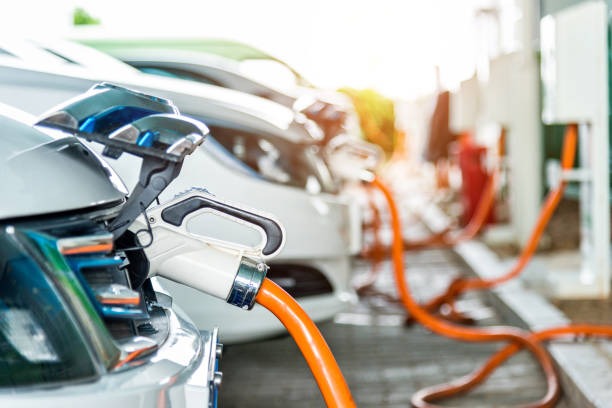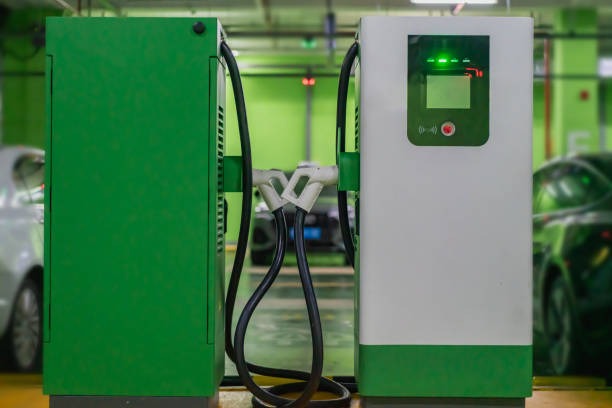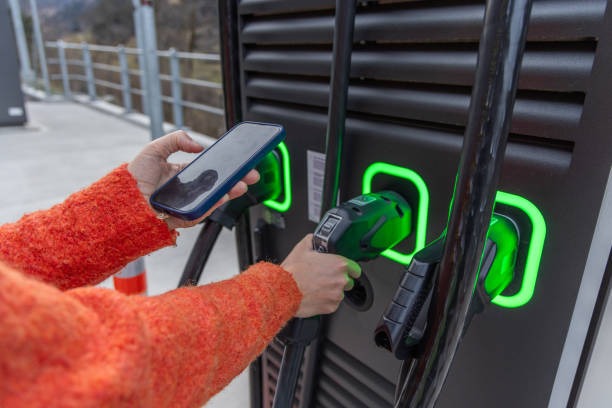Electric vehicles (EVs) are rapidly reshaping the transportation sector, and at the helm of these changes is EV charging technology. And now that adoption rates are also rising compared to past years, it becomes necessary for new or aspiring EV owners to understand the tech behind electric cars.
Here, we unravel the details about electric car charging technology and answer some of your questions, such as “How does EV charging technology work?”
How Does EV Charging Technology Work?
The mechanics of electric car charging technology go beyond just electricity flowing from the grid to your car battery through a port. Under the hood, several things take place, such as converting the alternating current (AC) to direct current (DC), which batteries can store.
In all these, your vehicle’s onboard charger acts as the referee; it manages the flow of energy, battery health, and charging safety. But what makes DC fast chargers lightning fast? They bypass the car’s onboard charger to deliver the DC straight to the battery. Smart chargers take it a notch higher by optimizing energy usage based on demand, time-of-day rates, and solar input.

Generally, how EV charging technology functions is a coordinated operation between charging equipment, software, and electricity. It’s a process where timing, current, and communication between vehicles and the charger matter a lot more than just “plug and play.”
EV Charging Protocols and Interfaces
Any charging session is governed by a set of rules, known as charging protocols. These are nothing but communication languages used by chargers and EVs to exchange vital information, like how much energy is required and when to stop charging.
In the United States, one of the most commonly used charging protocols is OCPP (Open Charge Point Protocol) for networked stations and ISO 15118, which offers plug-and-charge features. These charging protocols ensure compatibility and safety, especially at a public EV charging station where different EV models come across different chargers.
Think of EV charging protocols like a universal translator that makes sure everyone understands each other in a boardroom where everyone speaks their language.
Electric Car Charging Infrastructure
The charging infrastructure is growing fast here in the United States; the country boasts over 200,000 public EV charging stations as of October 2024. This is partly due to the federal support through the Bipartisan Infrastructure Law and private investments from networks like Tesla Supercharger, EVgo, and ChargePoint.
Charging infrastructure comprises public and private EV charging points:
1. Public EV Charging Station
These are charging stations available for the general public, often found near shopping malls, city centers, parks, and along interstate highways. Public EV charging stations offer varying charging speeds, from Level 2 chargers to ultra-rapid DC fast chargers. Most of these stations are networked, making it easier for drivers to locate, reserve, and pay using their phones.
2. Private EV Charging Points
These are mostly installed in homes, at workplaces, and in other privately operated spaces where cars are parked for longer periods. Private EV charging points often use Level 2 systems and offer a more cost-effective way to juice up for daily commutes. Businesses can also set up private chargers to offer additional perks to their staff or tenants.
If you’re considering installing an EV charger at your workplace, Charge Rigs offers robust DC fast chargers: Omega for permanent setups and FLEXX Mobile DC Fast Chargers for mobile charging.
Types of EV Chargers
Understanding the different types of EV chargers is a key part of owning an electric car or even setting up a charging station, whether public or private.
- Level 1 Charging
Level 1 charging happens in homes through a basic 120V household outlet readily available. It’s the tortoise in the race, delivering about 2 to 5 miles of range per hour. It’s ideal if you prefer to charge your EV overnight or drive a plug-in hybrid with a small battery capacity.
- Level 2 Charging
This is the sweet spot for most EV owners. A Level 2 charger requires a 240V outlet, just like your dryer, and offers 10 to 60 miles of range per hour. It’s common in both private and public EV charging stations, and offers a practical balance between cost and speed.
- Level 3 Charging / DC Fast Charging
Level 3 charging is often reserved for public charging stations where DC fast chargers can add over 100 miles of range in just 30 minutes. With advanced options like Charge Rigs’ Omega DC Fast Charger, the energy output can go up to 320 kW, which perfectly suits fleet operations while eliminating downtimes. Plus, it supports OCPP (Open Charge Point Protocol) integration to allow smooth communication for easy monitoring, charger tracking, and remotely managing charging network infrastructure.
Difference Between AC Vs DC in EV Charging
Another important aspect of EV charging technology worth understanding is the AC vs. DC. All wall outlets serve alternating current (AC). EV batteries, on the other hand, store only direct current (DC) energy, so they can’t be charged using AC.
So, under the hood, the car’s onboard charger converts the AC from the grid to DC. This is what happens in Level 1 and Level 2 EV charging. The conversion process takes a little bit of time, and the speed generally depends on the onboard charger’s capacity.
But what if you were charging using a DC fast charger? The direct current skips the middleman and delivers the energy straight to the batteries. That’s why DC charging is fast, but it also comes with much higher installation costs. Additionally, if used as the primary source of charging, it can cause battery degradation.

Charging Connectors Explained
The next important technology in charging that every EV owner or charging station operator needs to understand is the connector. When it comes to EVs, a plug isn’t just a plug; there are differences that must be put into consideration before plugging in to start charging.
- CCS
The Combined Charging System (CCS) is pretty common in North America and Europe, and supports both DC and AC charging. It’s compatible with most new EVs except Tesla, although you can use an adapter. If you use a public EV charging station, chances are you’re using CCS almost every time you charge.
- NACS
The North American Charging Standard (NACS) is Tesla’s proprietary connector and is being adopted by other automakers like GM and Ford. This switch to NACS is happening because it’s more compact, powerful, and is rapidly becoming the dominant format in the US, with Tesla Superchargers being its stronghold.
- CHAdeMO
This is an older Japanese standard that is common in EVs like the Nissan Leaf. It’s currently on the decline in the US, and fewer stations are being built with CHAdeMO support. This connector is used for DC fast charging in the Nissan Leaf and is still a viable option.
- GB/T
GB/T is China’s standard, just like CHAdeMO is a Japanese standard. However, GB/T is rarely seen in the US, unless you’re importing an EV from China. The “GB” is an acronym for “GuoBiao,” which means “national standard.” The “T” is for “tuijian,” meaning “recommended.
GB/T not only defines the specs for connectors, but also the charging interfaces and communication protocols between EVs and charging stations.
Environmental Impact of EV Charging
EV charging technology may sound more sustainable to everyone, until you start to look at where the electricity is coming from. Not all the power comes from sustainable sources like wind and solar; about 60% of grid power comes from non-renewable sources like natural gas.
However, EV charging is getting greener with the grid shifting towards renewable energy like solar, wind, and hydro. This means that charging your EV is increasingly leaving a lighter carbon footprint than driving an ICE (internal combustion engine) vehicle. Smart chargers are helping by pulling energy during off-peak hours or when clean energy is abundant. In short, even though EV charging isn’t carbon-free yet, it’s carbon-leaning and is getting better.
What Are the Latest Advancements in EV Charging Technology?
The EV charging docket is charging into the future, literally. We’re seeing the entry of ultra-fast 800V charging systems, bidirectional charging (where EVs power your appliances or feed the grid), and plug-and-charge features. The latter lets your car authenticate and start charging automatically without the need for a card or an app.
Wireless charging pads are also gaining traction. This is where you just drive into your garage, park, and charging kicks off automatically. Companies such as HEVO and WiTricity are piloting this tech in the US. This technology is already live in Trondheim, Norway, except that it’s wireless charging roads. It uses inductive charging where copper coils embedded in the road aid in the transfer of energy to EVs that are compatible.
Future Trends and Opportunities of EV Charging Technology?
Looking at the future of EV charging technology, it seems brighter than ever. We expect the tech to go beyond the usual “faster” and “smarter.” Think dynamic pricing based on the grid load, solar-optimized home chargers, battery energy storage systems, and even peer-to-peer energy sharing between EV owners.

Shifting to the public EV charging space, networks are rapidly growing. The federal NEVI program targets funding 500,000 public EV charging stations by 2030. This means that soon, rural and underserved areas in the US will cease to be EV dead zones.
For those in business, the growth of private EV charging points opens up opportunities to monetize unused parking, attract sustainability-minded customers, and tap into clean energy credits. Also, with IoT and AI syncing chargers with real-time traffic and power consumption, the charging experience for EV drivers is about to get seamless.
Final Thought
EV charging technology is rapidly evolving from a niche to become the backbone of future mobility. Whether topping off at a highway rest stop or plugging in at home, knowing how this whole EV charging thing works empowers you to drive smarter, greener, and more confidently. With the rapid adoption of EVs, things are about to get better, so it’s best to be prepared when these changes come knocking.


